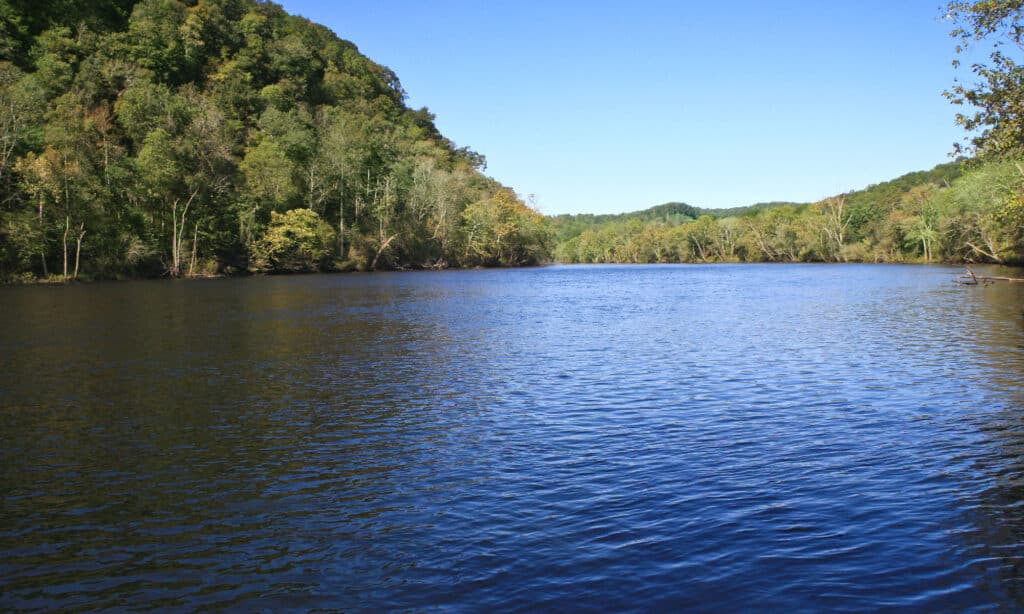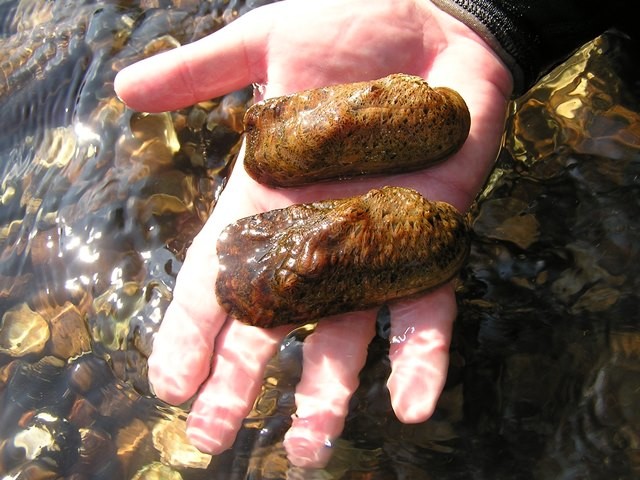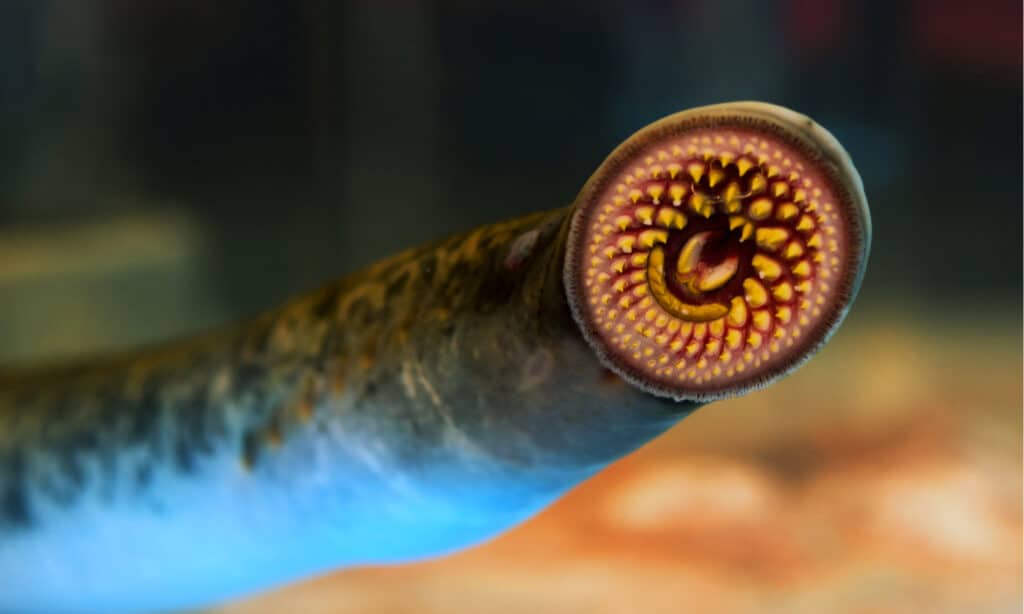How Wide is the Tennessee River at its Widest Point?
The Tennessee River is unique; it leaves the state, flows back into it, and then flows out again. This river is 652 miles long and has a wide range of marine life, insects, and mammals that thrive in its waters and near its banks. People also thrive off the Tennessee River, using it for food, navigation, and recreation.
As Tennessee offers so many benefits to people and animals, many ask how wide is the Tennessee River at its widest point. Let’s find out!
The Width of the Tennessee River

Kevin Ruck/Shutterstock.com
The Tennessee River reaches a distance of 1.5 miles at its widest point. The river’s width has allowed for the construction of several large dam walls along its course.
The Course of the Wide Tennessee River
The Tennessee River starts in Knoxville, Tennessee. It begins its journey at the confluence of the Holston and French Broad Rivers and then flows southwest. You can follow its course through East Tennessee until you end up in Chattanooga. This location is where it enters Alabama and straddles the border of Alabama along Mississippi.
Uniquely, the Tennessee River then returns to this state, creating the border between its middle and western regions. Then, this waterway ends when it enters the Ohio River in Paducah, Kentucky. But, before it ends, Tennessee enters Kentucky and separates the Jackson Purchase.
In total, this river flows through seven states. The river, which also flows through 123 different counties, has a basin that covers a total area of 40,900 square miles. The seven states that are home to the Tennessee River are:
- Tennessee
- Virginia
- North Carolina
- Alabama
- Georgia
- Mississippi
- Kentucky
Without tributaries, the Tennessee and other rivers wouldn’t amount to much. Likewise, Tennessee River comprises a range of tributaries. Four tributaries, the Clint, Flint, Sequatchie, and Elk, meet up with the Tennessee River from a northerly direction. Its other branches join from a southward direction.
These tributaries are the following:
- Holston River
- French River
- Broad River
- The Little Tennessee River
- Hiwassee River
- Duck River
- Ocoee River
The Uses of the Tennessee River

iStock.com/epantha
Cities use the Tennessee River for entertainment, commerce, and food mostly. Regardless, if you are looking for adventure on the Tennessee River, you can swim, kayak, canoe, fish, and enjoy river cruises.
But besides this, the Tennessee River has economic benefits for people nearby. Today, the river is used for municipal and industrial purposes, agriculture, and impoundments. About 38 facilities now have permits to discharge wastewater into the river, and the EPD has recorded 57 agricultural water withdrawal permits so far. Overall, the Tennessee River gives life to many cities along her banks.
In 1933, city officials founded the Tennessee Valley Authority (TVA) to develop areas along the Tennessee River. The TVA then built locks and reservoirs along this waterway to facilitate navigation, flood control, and generate power.
Now, there are many dams along the Tennessee River which are man-made. Moreover, some of the oldest dams on its path are the Hales Bar dam, constructed in 1913, the Wilson dam, built in 1925, and the Wheeler dam, completed in 1936.
Marine Life in the Tennessee River

Biologists and anglers are fond of this waterway because it is teaming with fish and other marine life, making it a popular attraction. Among its residents is the sturgeon, which is an odd-looking shark-like fish. But, if you are an angler interested in making a catch in the Tennessee River, you will likely also come across:
- Smallmouth Bass
- Largemouth Bass
- Striped Bass
- White Bass
- Sauger
- Blue Catfish
Besides these fish, the palezone shiner, slackwater darter, snail darter, and the spotfin chub live in the wide Tennessee River waters. Some of these fish are endangered, with others being close to extinction.
A diverse range of shellfish also lives in these waters, with many of the different species being endemic. Incredibly, biologists have recorded almost 90 distinct species of freshwater mussels here. If freshwater and marine life fascinate you, the Muscle Shoals is a popular spot to explore this phenomenon.
Another fascinating fact about the Tennessee River is that it is full of aquatic snails. Over 70 types of aquatic snails live alongside the myriad of mussels, with many also being pervasive.
This wide range of shellfish has given rise to a cultured pearl industry. Today, washboard and ebonyshell mussels produce lucrative pearl harvests, bringing profitability to surrounding areas.
Crayfish are also among the many shellfish that live in the Tennessee River. Many different crayfish species abound, the most impressive being the Tennessee bottlebrush crayfish. Only discovered in 2011, this crayfish is a giant, double the size of the other crayfish species in the Tennessee River.
Odd Animals Found in the Wide Tennessee River

Gena Melendrez/Shutterstock.com
Besides common fish and wildlife, the Tennessee River is home to some uncommon and odd wildlife. One of the most surprising residents is the freshwater jellyfish. Freshwater jellyfish, also known as peach blossom jellyfish, are translucent and grow to one inch.
The river is also home to an aquatic invertebrate known as a bryozoan. Bryozoans, also known as moss animals, grow in colonies and successfully filter the river water.
Lamprey is just one of the peculiar creatures swimming in the Tennessee River. This ancient fish is jawless scale-less, and resembles an eel. However, its large mouth has concentric rows of hooked teeth, allowing attachment to a host. Once attached, the lamprey feeds on the host’s skin or blood.
Another ancient inhabitant of the Tennessee River is the paddlefish. The paddlefish, also known as a spoonbill cat and shovelnose cat, is related to sturgeons and has been mistaken for a shark. These fish feed by widely opening their mouths and filtering the river water. Now that you know how wide the Tennessee River is at its widest point, read about the widest river on earth.
More from A-Z Animals
The Tennessee River is unique; it leaves the state, flows back into it, and then flows out again. This river is 652 miles long and has a wide range of marine life, insects, and mammals that thrive in its waters and near its banks. People also thrive off the Tennessee River, using it for food, navigation, and recreation.
As Tennessee offers so many benefits to people and animals, many ask how wide is the Tennessee River at its widest point. Let’s find out!
The Width of the Tennessee River

Kevin Ruck/Shutterstock.com
The Tennessee River reaches a distance of 1.5 miles at its widest point. The river’s width has allowed for the construction of several large dam walls along its course.
The Course of the Wide Tennessee River
The Tennessee River starts in Knoxville, Tennessee. It begins its journey at the confluence of the Holston and French Broad Rivers and then flows southwest. You can follow its course through East Tennessee until you end up in Chattanooga. This location is where it enters Alabama and straddles the border of Alabama along Mississippi.
Uniquely, the Tennessee River then returns to this state, creating the border between its middle and western regions. Then, this waterway ends when it enters the Ohio River in Paducah, Kentucky. But, before it ends, Tennessee enters Kentucky and separates the Jackson Purchase.
In total, this river flows through seven states. The river, which also flows through 123 different counties, has a basin that covers a total area of 40,900 square miles. The seven states that are home to the Tennessee River are:
- Tennessee
- Virginia
- North Carolina
- Alabama
- Georgia
- Mississippi
- Kentucky
Without tributaries, the Tennessee and other rivers wouldn’t amount to much. Likewise, Tennessee River comprises a range of tributaries. Four tributaries, the Clint, Flint, Sequatchie, and Elk, meet up with the Tennessee River from a northerly direction. Its other branches join from a southward direction.
These tributaries are the following:
- Holston River
- French River
- Broad River
- The Little Tennessee River
- Hiwassee River
- Duck River
- Ocoee River
The Uses of the Tennessee River

iStock.com/epantha
Cities use the Tennessee River for entertainment, commerce, and food mostly. Regardless, if you are looking for adventure on the Tennessee River, you can swim, kayak, canoe, fish, and enjoy river cruises.
But besides this, the Tennessee River has economic benefits for people nearby. Today, the river is used for municipal and industrial purposes, agriculture, and impoundments. About 38 facilities now have permits to discharge wastewater into the river, and the EPD has recorded 57 agricultural water withdrawal permits so far. Overall, the Tennessee River gives life to many cities along her banks.
In 1933, city officials founded the Tennessee Valley Authority (TVA) to develop areas along the Tennessee River. The TVA then built locks and reservoirs along this waterway to facilitate navigation, flood control, and generate power.
Now, there are many dams along the Tennessee River which are man-made. Moreover, some of the oldest dams on its path are the Hales Bar dam, constructed in 1913, the Wilson dam, built in 1925, and the Wheeler dam, completed in 1936.
Marine Life in the Tennessee River

Biologists and anglers are fond of this waterway because it is teaming with fish and other marine life, making it a popular attraction. Among its residents is the sturgeon, which is an odd-looking shark-like fish. But, if you are an angler interested in making a catch in the Tennessee River, you will likely also come across:
- Smallmouth Bass
- Largemouth Bass
- Striped Bass
- White Bass
- Sauger
- Blue Catfish
Besides these fish, the palezone shiner, slackwater darter, snail darter, and the spotfin chub live in the wide Tennessee River waters. Some of these fish are endangered, with others being close to extinction.
A diverse range of shellfish also lives in these waters, with many of the different species being endemic. Incredibly, biologists have recorded almost 90 distinct species of freshwater mussels here. If freshwater and marine life fascinate you, the Muscle Shoals is a popular spot to explore this phenomenon.
Another fascinating fact about the Tennessee River is that it is full of aquatic snails. Over 70 types of aquatic snails live alongside the myriad of mussels, with many also being pervasive.
This wide range of shellfish has given rise to a cultured pearl industry. Today, washboard and ebonyshell mussels produce lucrative pearl harvests, bringing profitability to surrounding areas.
Crayfish are also among the many shellfish that live in the Tennessee River. Many different crayfish species abound, the most impressive being the Tennessee bottlebrush crayfish. Only discovered in 2011, this crayfish is a giant, double the size of the other crayfish species in the Tennessee River.
Odd Animals Found in the Wide Tennessee River

Gena Melendrez/Shutterstock.com
Besides common fish and wildlife, the Tennessee River is home to some uncommon and odd wildlife. One of the most surprising residents is the freshwater jellyfish. Freshwater jellyfish, also known as peach blossom jellyfish, are translucent and grow to one inch.
The river is also home to an aquatic invertebrate known as a bryozoan. Bryozoans, also known as moss animals, grow in colonies and successfully filter the river water.
Lamprey is just one of the peculiar creatures swimming in the Tennessee River. This ancient fish is jawless scale-less, and resembles an eel. However, its large mouth has concentric rows of hooked teeth, allowing attachment to a host. Once attached, the lamprey feeds on the host’s skin or blood.
Another ancient inhabitant of the Tennessee River is the paddlefish. The paddlefish, also known as a spoonbill cat and shovelnose cat, is related to sturgeons and has been mistaken for a shark. These fish feed by widely opening their mouths and filtering the river water. Now that you know how wide the Tennessee River is at its widest point, read about the widest river on earth.





